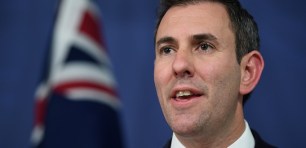
ATO commissioner of taxation Chris Jordan. Source: AAP/Lukas Coch.
The annual conference of one of the world’s most prominent accounting software vendors, Xero, was used by tax commissioner Chris Jordan to partially unveil the Australian Taxation Office’s (ATO’s) new digital strategy.
Jordan told Xerocon — held in Sydney over the past week — the tax office wants to be fully digital by 2030, but that the full strategy will be delivered in due course.
He said that the strategy seeks to ensure that “nobody gets left behind”.
“The strategy is framed by four pillars and underpinned by five principles. One of the four pillars is a collaboration with our partners, and I really want to emphasise that point today,” Jordan said.
“In the midst of the chaos of the pandemic, we worked with you to deliver over $164 billion in stimulus to Australians when they needed it most.”
Jordan said that tax agents and accountants were partners in the system.
The first principle the ATO has at the heart of its digital plans for 2030 is to work with the software tools people already use.
Compliance becomes easier, Jordan said, when people are able to use the systems they already have to engage with the tax office and pay their taxes.
This process is an element of the OECD’s Tax Administration 3.0, which enables what Jordan told the Xero audience was data to be able to flow “from the systems taxpayers already use, to ours, without any extra effort or intervention from them”.
Existing systems of payment to the tax office result in taxes being paid after the event that is taxable under law has occurred.
Tax Administration 3.0 is about real-time reporting and payment, Jordan said, and such a system would mean that the tax office gets its take more quickly from the taxpayer.
Another concept at the centre of the tax office’s digital revolution is the notion of building on electronic invoicing and creating an environment where good and services tax report is not longer periodic, but that systems can simply aggregate that information as transactions occur leading to real-time reporting and payments of GST.
The tax office will also consider using existing systems for multiple purposes wherever possible, Jordan said, and any redesign of systems will have multiple uses in mind.
“JobKeeper is an excellent example of this in action. Together with the Fiscal group in Treasury, we designed the JobKeeper payments around the systems we had already built for STP. This facilitated fast and efficient delivery, and importantly, ensured integrity,” Jordan said.
“When an employer applied for JobKeeper and said they had 8 employees, we knew whether that was true or not based on their regular payroll reporting.
“It also meant we could move quickly. We built the system and started making payments within 6 weeks, and 97% of payments were made within 4 business days from application.”
This article was first published by The Mandarin.
Handpicked for you

“Do or die”: Tech players welcome government commitment to $1.55 billion “bonus” tax offsets for SMEs



COMMENTS
SmartCompany is committed to hosting lively discussions. Help us keep the conversation useful, interesting and welcoming. We aim to publish comments quickly in the interest of promoting robust conversation, but we’re a small team and we deploy filters to protect against legal risk. Occasionally your comment may be held up while it is being reviewed, but we’re working as fast as we can to keep the conversation rolling.
The SmartCompany comment section is members-only content. Please subscribe to leave a comment.
The SmartCompany comment section is members-only content. Please login to leave a comment.